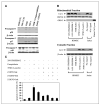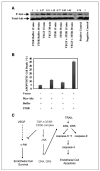A double hit to kill tumor and endothelial cells by TRAIL and antiangiogenic 3TSR
- PMID: 19366809
- PMCID: PMC2981788
- DOI: 10.1158/0008-5472.CAN-08-2940
A double hit to kill tumor and endothelial cells by TRAIL and antiangiogenic 3TSR
Abstract
As tumor development relies on a coordination of angiogenesis and tumor growth, an efficient antitumor strategy should target both the tumor and its associated vessels. Tumor necrosis factor-related apoptosis-inducing ligand (TRAIL) induces apoptosis in a tumor-selective manner. Additionally, thrombospondin-1, a naturally occurring inhibitor of angiogenesis, and a recombinant protein containing functional domains of thrombospondin-1, 3TSR, have been shown to be necessary and sufficient to inhibit tumor angiogenesis. Here, we show that a combination of a TRAIL receptor 2 agonist antibody, Lexatumumab, and 3TSR results in a significantly enhanced and durable tumor inhibition. We further observed that 3TSR induces apoptosis in primary endothelial cells by up-regulating the expression of TRAIL receptors 1 and 2 in a CD36 and Jun NH(2)-terminal kinase-dependent manner leading to the activation of both intrinsic and extrinsic apoptotic machineries. The modulation of these pathways is critical for 3TSR-induced apoptosis as disrupting either via specific inhibitors reduced apoptosis. Moreover, 3TSR attenuates the Akt survival pathway. These studies indicate that 3TSR plays a critical role in regulating the proapoptotic signaling pathways that control growth and death in endothelial cells and that a combination of TRAIL and 3TSR acts as a double hit against tumor and tumor-associated vessels.
Figures






Similar articles
-
Antiangiogenic variant of TSP-1 targets tumor cells in glioblastomas.Mol Ther. 2015 Feb;23(2):235-43. doi: 10.1038/mt.2014.214. Epub 2014 Oct 31. Mol Ther. 2015. PMID: 25358253 Free PMC article.
-
Antiangiogenic treatment with the three thrombospondin-1 type 1 repeats recombinant protein in an orthotopic human pancreatic cancer model.Clin Cancer Res. 2005 Mar 15;11(6):2337-44. doi: 10.1158/1078-0432.CCR-04-1900. Clin Cancer Res. 2005. PMID: 15788685
-
2-methoxy-5-amino-N-hydroxybenzamide sensitizes colon cancer cells to TRAIL-induced apoptosis by regulating death receptor 5 and survivin expression.Mol Cancer Ther. 2011 Oct;10(10):1969-81. doi: 10.1158/1535-7163.MCT-11-0316. Epub 2011 Aug 4. Mol Cancer Ther. 2011. PMID: 21817114
-
Prediction of proapoptotic anticancer therapeutic response in vivo based on cell death visualization and TRAIL death ligand-receptor interaction.Cancer Biol Ther. 2011 Aug 15;12(4):335-48. doi: 10.4161/cbt.12.4.17174. Epub 2011 Aug 15. Cancer Biol Ther. 2011. PMID: 21785270
-
Thrombospondin and apoptosis: molecular mechanisms and use for design of complementation treatments.Curr Drug Targets. 2008 Oct;9(10):851-62. doi: 10.2174/138945008785909347. Curr Drug Targets. 2008. PMID: 18855619 Free PMC article. Review.
Cited by
-
Lysophosphatidic acid suppresses endothelial cell CD36 expression and promotes angiogenesis via a PKD-1-dependent signaling pathway.Blood. 2011 Jun 2;117(22):6036-45. doi: 10.1182/blood-2010-12-326017. Epub 2011 Mar 25. Blood. 2011. PMID: 21441463 Free PMC article.
-
Thrombospondin-1 type 1 repeats in a model of inflammatory bowel disease: transcript profile and therapeutic effects.PLoS One. 2012;7(4):e34590. doi: 10.1371/journal.pone.0034590. Epub 2012 Apr 3. PLoS One. 2012. PMID: 22509329 Free PMC article.
-
Molecular basis for the regulation of angiogenesis by thrombospondin-1 and -2.Cold Spring Harb Perspect Med. 2012 May;2(5):a006627. doi: 10.1101/cshperspect.a006627. Cold Spring Harb Perspect Med. 2012. PMID: 22553494 Free PMC article. Review.
-
Antiangiogenic variant of TSP-1 targets tumor cells in glioblastomas.Mol Ther. 2015 Feb;23(2):235-43. doi: 10.1038/mt.2014.214. Epub 2014 Oct 31. Mol Ther. 2015. PMID: 25358253 Free PMC article.
-
Role of CD36 in cancer progression, stemness, and targeting.Front Cell Dev Biol. 2022 Dec 8;10:1079076. doi: 10.3389/fcell.2022.1079076. eCollection 2022. Front Cell Dev Biol. 2022. PMID: 36568966 Free PMC article. Review.
References
-
- Armstrong LC, Bornstein P. Thrombospondins 1 and 2 function as inhibitors of angiogenesis. Matrix Biol. 2003;22:63–71. - PubMed
-
- Nor JE, Mitra RS, Sutorik MM, Mooney DJ, Castle VP, Polverini PJ. Thrombospondin-1 induces endothelial cell apoptosis and inhibits angiogenesis by activating the caspase death pathway. J Vasc Res. 2000;37:209–18. - PubMed
-
- Stupack DG, Cheresh DA. Apoptotic cues from the extracellular matrix: regulators of angiogenesis. Oncogene. 2003;22:9022–9. - PubMed
-
- Jimenez B, Volpert OV, Crawford SE, Febbraio M, Silverstein RL, Bouck N. Signals leading to apoptosis-dependent inhibition of neovascularization by thrombospondin 1. Nat Med. 2000;6:41–8. - PubMed
-
- Danial NN, Korsmeyer SJ. Cell death: critical control points. Cell. 2004;116:205–19. - PubMed
Publication types
MeSH terms
Substances
Grants and funding
LinkOut - more resources
Full Text Sources
Other Literature Sources
Research Materials
Miscellaneous

